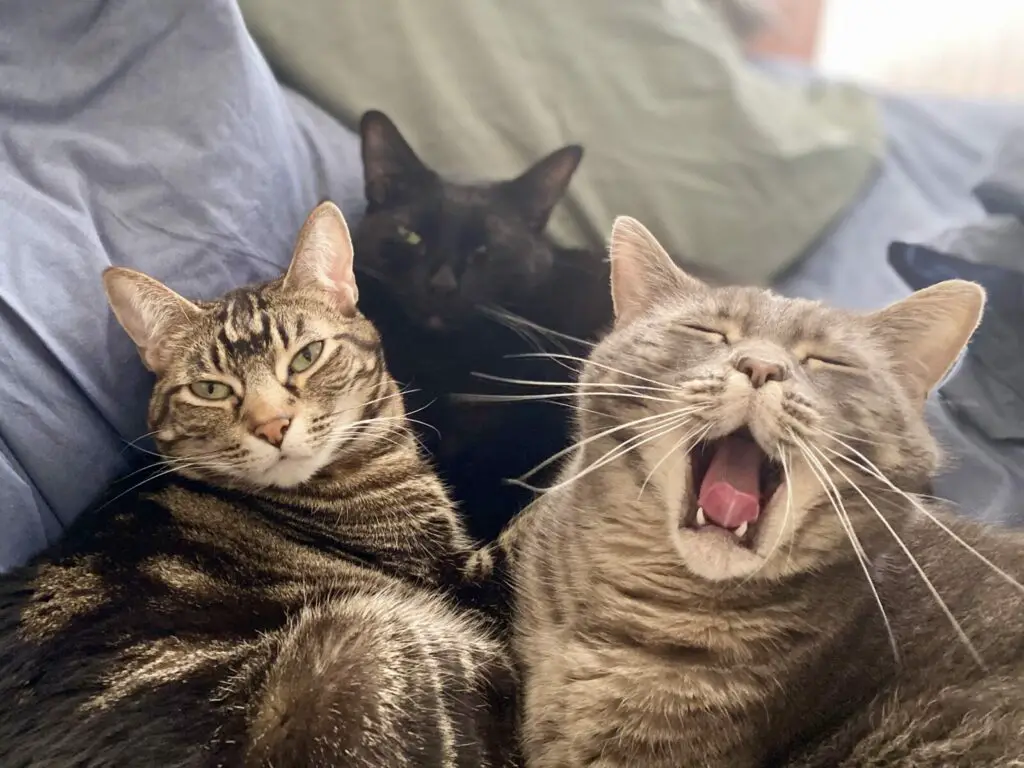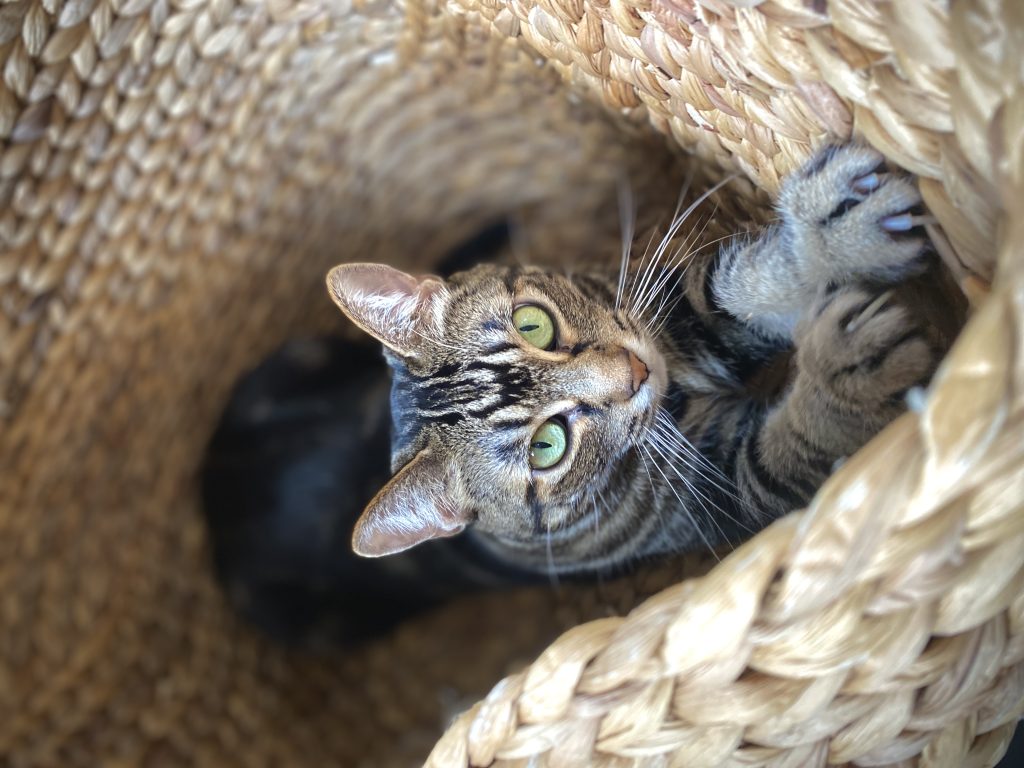10 Things You Should Look For When Meeting Adoptable Kittens and Cats
You’ve determined that you’re ready to get a cat, you’ve prepared your home, and you’ve set your intentions for what your goals are for adopting. Now it’s time to go out and meet some kitties!
Hold on, though – how do you decide on a cat when there are so many choices? What should you look for? Are there any red flags you should be aware of?

This article breaks down what to look for when you go out and meet adoptable cats.
Important Things to Keep in Mind
When you go to the shelter, you will probably find several rows of enclosures, each with one or more available kittens or cats. It is important to keep in mind that the cats you’re meeting are probably very stressed out.
1. Consider the Shelter Environment’s Effect on Each Cat
This means that many of the cats will not be revealing their full personality. In fact, some may be huddled in the back corner, showing zero interest in greeting you.
But this is not necessarily a reason to dismiss them as candidates for adoption. If you do dismiss them immediately and only consider the cats who eagerly greet you, you may be missing out on a real gem.
2. Look for Hidden Gems
You should also keep in mind that it is very common for there to be several available cats that everyone is passing by.
These less popular cats are deemed “less-adoptable” simply because they’re not kittens, they seem shy or withdrawn, they have dark fur, or they have some special needs.
Tragically, these cats may end up being euthanized because they weren’t adopted after a certain period of time, even though they’re perfectly healthy. So make sure you consider these “undercats” for adoption as well.
3. Make Note of First Impressions
Initially, you may want to simply observe the cats that you are most drawn to.
- What are they doing?
- Do they seem stressed out or withdrawn?
- Or are they energetic and outgoing?
- Are they interacting with any other cats?
- Do they seek your attention as you approach the enclosure?
- Or do they hiss, retreat, or try to hide?
There aren’t necessarily any right or wrong answers to any of those questions. The point here is just to observe and note your initial impressions.
Sometimes, there will be some connection with a cat that doesn’t meet your “ideal” characteristics or profile that you had in mind going in.
And often, this connection is one of the most important factors in the decision to adopt a particular cat. Be open to this possibility.
Also, ask if there are any sweet cats that other people are overlooking. Sometimes staff members who know the animals will be able to point out a certain cat that seems withdrawn in the enclosure, but really shines once it has developed some trust with a person.
4. Engage in Interactions
After your initial observations, if there are any cats that you are interested in, ask if you can spend some time interacting with them. Many shelters have a separate room prospective adopters can hang out in with a cat.
You can learn a lot about a cat by spending this kind of time before you decide to adopt.
When you sit in a room with them, it allows the cat to take things on their own terms. They can initiate contact while also having the freedom to move freely around the room.
5. Make Multiple Visits
It can also help to have multiple visits with the same cat. If you hang out with a cat more than once across several days, you may end up seeing more of their true personality.
6. Leverage Foster Knowledge
If you’re meeting cats that are being fostered, the person doing the fostering is a goldmine of information.
Have them tell you about the cat’s positive and negative qualities, their preferences, and personality.
Ask whether the cat requires any special care and how they compare to other cats they have known and cared for. What are the cat’s preferences, peculiarities, and unique traits?
Look for rescue agencies that place cats with fosters. They often put on adoption events where you’re able to not only meet the cats but also speak with the fosters who already know the cats very well.
The downside of meeting cats at an adoption event is that it can be harder to get a read on the cat’s personality. And there often isn’t space where you can hang out with the cat like you can in a shelter.
But again, being able to speak with the person fostering the cats is super valuable.
7. Ask Key Questions
Regardless of where you’re meeting potential adoptees, here are some helpful questions to consider:
- Does the cat seek affection and enjoy petting? How do they like to be pet – on the head, chin, back?
- Do they feel comfortable enough to engage in some play? Ask the staff if there are any toys you can use when hanging out with a cat.
- How does the cat react to new sights, sounds, smells and environments? Do they seem anxious, curious, aloof, confident?
- Does the cat enjoy being held or picked up?
- How much energy does the staff think the cat has – high, medium or low?
Asking questions like these will give you a better sense of the cat’s personality and what they may be like at home. The more interactions you can have, the better sense you’ll develop.
8. Watch for Red Flags
I like to think of red flags in two separate categories. One is red flags about the adoption organization and process. The other is red flags about the cat and whether there’s a good match with your intentions and experience level.
Red flags about the cats themselves
- Aggressive behavior like swiping, growling, biting, or hissing
- Extreme fearfulness and hiding even after multiple interactions
- Excessive vocalization or crying during interactions
- Chronic litter box avoidance
- Not eating
- Physical signs of illness
These things don’t necessarily mean the cat won’t make a good pet. But it may suggest they could need more time, patience and TLC to transition well into a new home.
You definitely don’t want to take on more than you can handle. Speaking with a staff member can help clarify things that seem like they could be red flags.
9. Assess the Adoption Organization – Red Flags to Look For
- Making kittens available for adoption before they’re ready. (Kittens should not be separated from their mom before the age of 8 weeks, and really need until 10-12 weeks of age to be ready for adoption.)
- Lack of thorough screening process for potential adopters to make sure animals go to good homes.
- Facility is not kept clean or the conditions for the cats are unsanitary.
It’s always a good idea to make sure you’re supporting an organization that has ethical practices.
10. Trust Your Judgment & Intuition
When adopting a cat, go with your intuition. The connection you feel, however inexplicable, is huge. In fact, if a cat just feels like the right fit, it may be that the cat has already chosen you!
Read Next: Our structured list of questions to ask during the adoption process.

